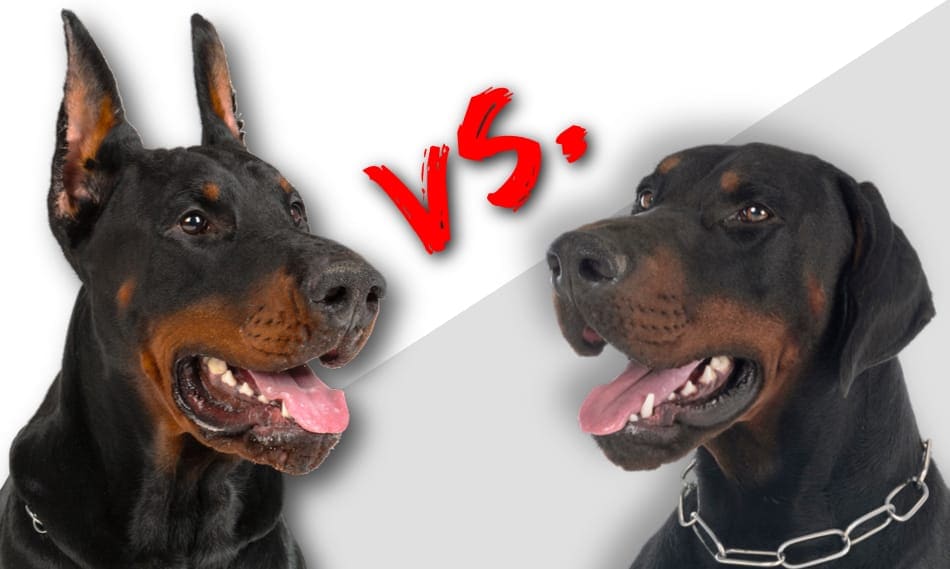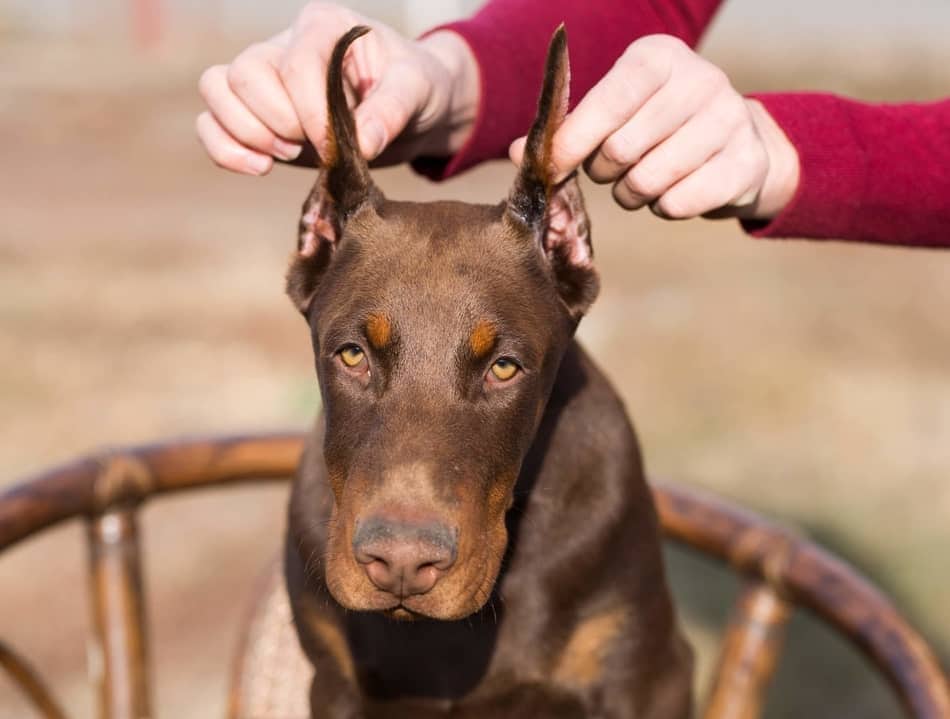The practice of cropping Doberman ears has been a topic of controversy among dog lovers for years. While it was once a common practice for Doberman Pinschers to have their ears cropped for aesthetic purposes, many countries and organizations have now banned or discouraged this procedure. However, the debate still rages on about whether or not cropping is necessary or beneficial for the breed. So, can you crop a Doberman? Let’s take a closer look.
The history of ear cropping in the Doberman breed dates back to the early 20th century when it was believed to enhance their appearance and improve their ability to hear and locate sounds. However, research has shown that ear cropping has no impact on a dog’s hearing or health and is purely a cosmetic procedure. Today, many countries and organizations, such as the American Veterinary Medical Association (AVMA) and the Australian Veterinary Association (AVA), oppose ear cropping due to the unnecessary pain and risks it imposes on the dog. As a result, many responsible breeders and owners now choose to keep their Doberman’s ears natural, embracing the breed’s unique and natural appearance.
Practices regarding ear cropping in Doberman Pinschers vary between regions and countries. In some areas, ear cropping is a common procedure performed for cosmetic reasons. However, it is important to note that ear cropping is a surgical procedure and should be performed by a professional veterinarian. The decision to crop a Doberman’s ears should be based on individual preferences, local regulations, and the breed standards. It is recommended to consult with your veterinarian and consider both the benefits and potential risks before deciding to crop a Doberman’s ears.

Can You Crop Doberman?
Doberman Pinschers are known for their sleek and muscular physique, as well as their distinctive cropped ears. However, there is some debate surrounding the practice of ear cropping. In this article, we will explore the topic of whether or not you can crop a Doberman’s ears, discussing the process, potential benefits, and ethical considerations.
What is Ear Cropping?
Ear cropping is a cosmetic surgical procedure in which a dog’s ears are reshaped by removing part of the ear tissue and then suturing the remaining tissue to create a desired shape. This procedure is typically done when the dog is still a puppy, usually between 7 and 12 weeks old. The Doberman Pinscher is one of several dog breeds that have traditionally undergone ear cropping for aesthetic purposes.
The American Kennel Club (AKC) breed standard for Doberman Pinschers actually recommends that their ears be cropped. However, it is important to note that ear cropping is a personal choice and not a requirement. Some owners choose to leave their Doberman’s ears natural, while others opt for the traditional cropped look.
The Ear Cropping Procedure
If you decide to crop your Doberman’s ears, it is crucial to consult with a reputable and experienced veterinarian who specializes in the procedure. The process typically involves the following steps:
- Sedation or anesthesia: The dog is sedated or placed under general anesthesia to ensure their comfort and safety during the procedure.
- Ear measurement and marking: The veterinarian will carefully measure and mark the desired length and shape for the cropped ears.
- Tissue removal: Using surgical tools, the veterinarian will remove the predetermined portion of the ear tissue.
- Suturing: The remaining tissue is then sutured together to create the desired shape of the ears.
- Aftercare: Following the procedure, the dog will require medication, bandages, and regular follow-up visits to monitor their healing process.
It is important to note that ear cropping is a surgical procedure and carries risks, as well as potential complications. There may be the possibility of infection, improper healing, or changes in ear positioning. It is crucial to discuss these risks with your veterinarian and follow their aftercare instructions carefully.
Benefits of Ear Cropping
Proponents of ear cropping argue that there are potential benefits to the procedure. Some of these claimed benefits include:
- Aesthetics: Many dog owners and breeders believe that cropped ears enhance the Doberman’s appearance and adherence to breed standards.
- Easier care: Cropped ears may be easier to clean and maintain compared to long, natural ears, as they do not trap dirt, debris, or moisture as easily.
- Reduced risk of ear infections: Some believe that cropped ears may reduce the risk of ear infections by improving air circulation and preventing ear canal blockage.
It is important to note that the perceived benefits of ear cropping are a matter of personal opinion and debate within the veterinary community. Many veterinarians and animal welfare organizations argue against the procedure, citing ethical concerns and the potential risks involved.
Ethical Considerations
The topic of ear cropping raises ethical considerations and has sparked controversy among dog owners and animal welfare advocates. Some arguments against ear cropping include:
- Pain and distress: The procedure can cause pain and discomfort for the dog, both during and after the surgery.
- Unnecessary alteration: Critics argue that ear cropping is a purely cosmetic procedure that serves no functional purpose and may compromise the dog’s natural appearance and ability to communicate through ear movements.
- Individual choice: Advocates for leaving ears natural argue that a dog’s physical features should not be altered solely for aesthetic reasons, as it is a personal choice based on breed standards rather than the dog’s well-being.
It is essential to consider both sides of the argument and conduct thorough research before making a decision about ear cropping. Consulting with a veterinarian and considering the potential risks, benefits, and ethical implications can help you make an informed choice that aligns with your beliefs and the well-being of your Doberman.
Should You Crop Your Doberman’s Ears?
Deciding whether or not to crop your Doberman’s ears is a personal decision that should be based on careful consideration of various factors, including your preferences and beliefs, the potential risks and benefits, and the ethical considerations discussed above.
Ultimately, there is no right or wrong answer, and it is up to each individual dog owner to make an informed and responsible choice. It is crucial to consult with your veterinarian and gather all the necessary information before deciding whether to proceed with ear cropping.
If you do choose to crop your Doberman’s ears, remember to find a reputable veterinarian who has experience with the procedure and can provide proper care and guidance throughout the process.
Can you crop a Doberman?
If you are wondering if you can crop a Doberman’s ears, here are some key takeaways for you:
- Cropping a Doberman’s ears is a personal choice and not necessary for their health or well-being.
- The procedure involves removing a portion of the dog’s ears to achieve a desired shape.
- Ear cropping should only be done by a professional veterinarian who is experienced in the procedure.
- Some countries have banned ear cropping due to ethical concerns.
- Dobermans with cropped ears may have a different appearance, but it does not affect their overall temperament or ability to be a loving companion.
Frequently Asked Questions
In this section, we will answer some common questions related to cropping Doberman ears.
1. Is it necessary to crop a Doberman’s ears?
No, it is not necessary to crop a Doberman’s ears. Ear cropping is a personal preference and is not required for the health or well-being of the dog. Some owners choose to crop their Doberman’s ears for aesthetic purposes or to adhere to breed standards, but it is not a mandatory procedure.
It’s important to note that cropping a dog’s ears should only be done by a professional veterinarian who has experience and expertise in performing the procedure. If you are considering ear cropping for your Doberman, it is essential to do thorough research, consult with your veterinarian, and make an informed decision.
2. Does ear cropping affect a Doberman’s hearing?
Ear cropping, when done correctly and by a skilled veterinarian, should not affect a Doberman’s hearing. The primary purpose of ear cropping is to reshape the ears for appearance, particularly to achieve the characteristic “alert” look of the Doberman breed.
However, it is essential to consider that any surgical procedure carries some risks, including potential complications that could impact the dog’s hearing. It is crucial to consult with your veterinarian about the potential risks and benefits of ear cropping before making a decision.
3. What is involved in the process of cropping a Doberman’s ears?
The process of cropping a Doberman’s ears involves surgically removing a portion of the ear, shaping it, and then bandaging it to promote proper healing and ear carriage. The procedure is typically done when the puppy is around 7 to 12 weeks old, as the ears are still soft and pliable at this age.
After the surgery, the puppy will need to wear a protective head wrap or cone to prevent them from scratching or rubbing their ears. The bandages are usually changed regularly, and the healing process can take several weeks. It is crucial to follow your veterinarian’s instructions for post-operative care to ensure proper healing.
4. Are there any risks or complications associated with ear cropping?
Like any surgical procedure, ear cropping carries some risks and potential complications. These can include infection, excessive bleeding, delayed healing, scarring, and changes in ear shape or position. It is essential to choose a skilled and experienced veterinarian to minimize these risks.
Additionally, it’s worth noting that some countries or regions have legal restrictions or regulations regarding ear cropping. It is important to familiarize yourself with the laws and regulations in your area before considering ear cropping for your Doberman.
5. Can I crop my Doberman’s ears if they are already fully grown?
While it is possible to crop the ears of an adult Doberman, the procedure is more complicated and poses higher risks compared to cropping a puppy’s ears. Adult Doberman’s ears are more developed and less pliable, making the surgery more challenging.
Additionally, the healing process may take longer in adult dogs, and the final result may not be as predictable. If you are considering ear cropping for your Doberman, it is generally recommended to do so when they are still a puppy, following the appropriate age and guidelines provided by your veterinarian.

Cropped Ears vs. Natural Ears: Which is Better?
In summary, cropping a Doberman’s ears is a cosmetic procedure that involves removing a portion of the dog’s ear to achieve a specific look. However, it is important to note that ear cropping is a controversial practice that is largely considered unnecessary and inhumane by many animal welfare organizations and veterinarians.
It’s essential to prioritize the well-being and comfort of our pets, and many countries and regions have actually banned this practice. Ultimately, the decision to crop a Doberman’s ears should be carefully considered, taking into account the potential risks, ethical concerns, and the dog’s overall welfare.
